An official website of the United States government
 United States Department of Labor
United States Department of Labor
Locate and notify customers of delinquent accounts by mail, telephone, or personal visit to solicit payment. Duties include receiving payment and posting amount to customerís account, preparing statements to credit department if customer fails to respond, initiating repossession proceedings or service disconnection, and keeping records of collection and status of accounts.
Employment estimate and mean wage estimates for Bill and Account Collectors:
| Employment (1) | Employment RSE (3) |
Mean hourly wage |
Mean annual wage (2) |
Wage RSE (3) |
|---|---|---|---|---|
| 190,910 | 2.8 % | $ 22.12 | $ 46,020 | 0.3 % |
Percentile wage estimates for Bill and Account Collectors:
| Percentile | 10% | 25% | 50% (Median) |
75% | 90% |
|---|---|---|---|---|---|
| Hourly Wage | $ 15.36 | $ 17.91 | $ 21.27 | $ 24.36 | $ 29.98 |
| Annual Wage (2) | $ 31,960 | $ 37,260 | $ 44,250 | $ 50,680 | $ 62,360 |
Industries with the highest published employment and wages for Bill and Account Collectors are provided. For a list of all industries with employment in Bill and Account Collectors, see the Create Customized Tables function.
Industries with the highest levels of employment in Bill and Account Collectors:
| Industry | Employment (1) | Percent of industry employment | Hourly mean wage | Annual mean wage (2) |
|---|---|---|---|---|
| Business Support Services | 46,260 | 6.16 | $ 18.87 | $ 39,250 |
| Nondepository Credit Intermediation | 19,140 | 3.47 | $ 21.17 | $ 44,040 |
| Credit Intermediation and Related Activities (5221 and 5223 only) | 17,700 | 0.87 | $ 23.37 | $ 48,620 |
| Management of Companies and Enterprises | 14,630 | 0.53 | $ 23.58 | $ 49,040 |
| General Medical and Surgical Hospitals | 7,690 | 0.13 | $ 23.25 | $ 48,360 |
Industries with the highest concentration of employment in Bill and Account Collectors:
| Industry | Employment (1) | Percent of industry employment | Hourly mean wage | Annual mean wage (2) |
|---|---|---|---|---|
| Business Support Services | 46,260 | 6.16 | $ 18.87 | $ 39,250 |
| Nondepository Credit Intermediation | 19,140 | 3.47 | $ 21.17 | $ 44,040 |
| Credit Intermediation and Related Activities (5221 and 5223 only) | 17,700 | 0.87 | $ 23.37 | $ 48,620 |
| Office Administrative Services | 4,440 | 0.80 | $ 22.28 | $ 46,350 |
| Accounting, Tax Preparation, Bookkeeping, and Payroll Services | 6,210 | 0.56 | $ 22.86 | $ 47,550 |
Top paying industries for Bill and Account Collectors:
| Industry | Employment (1) | Percent of industry employment | Hourly mean wage | Annual mean wage (2) |
|---|---|---|---|---|
| Natural Gas Distribution | 340 | 0.31 | $ 38.57 | $ 80,230 |
| Semiconductor and Other Electronic Component Manufacturing | 110 | 0.03 | $ 37.21 | $ 77,390 |
| Utility System Construction | 160 | 0.03 | $ 35.59 | $ 74,030 |
| Computer and Peripheral Equipment Manufacturing | 40 | 0.03 | $ 34.18 | $ 71,100 |
| Drycleaning and Laundry Services | 130 | 0.05 | $ 33.94 | $ 70,600 |
States and areas with the highest published employment, location quotients, and wages for Bill and Account Collectors are provided. For a list of all areas with employment in Bill and Account Collectors, see the Create Customized Tables function.
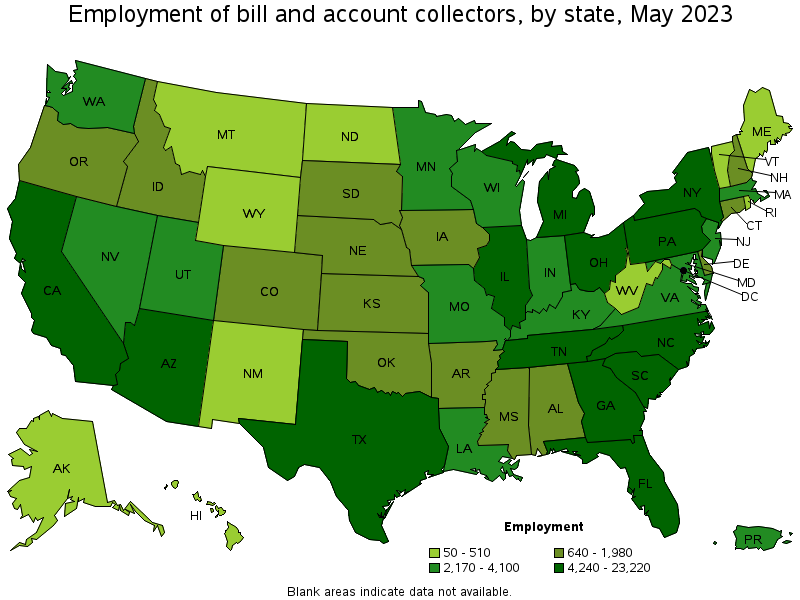
States with the highest employment level in Bill and Account Collectors:
| State | Employment (1) | Employment per thousand jobs | Location quotient (9) | Hourly mean wage | Annual mean wage (2) |
|---|---|---|---|---|---|
| California | 23,220 | 1.29 | 1.03 | $ 25.85 | $ 53,770 |
| Texas | 22,710 | 1.68 | 1.33 | $ 20.87 | $ 43,420 |
| Florida | 17,130 | 1.79 | 1.42 | $ 21.29 | $ 44,280 |
| New York | 9,160 | 0.98 | 0.78 | $ 24.45 | $ 50,850 |
| Ohio | 8,970 | 1.64 | 1.30 | $ 20.16 | $ 41,920 |
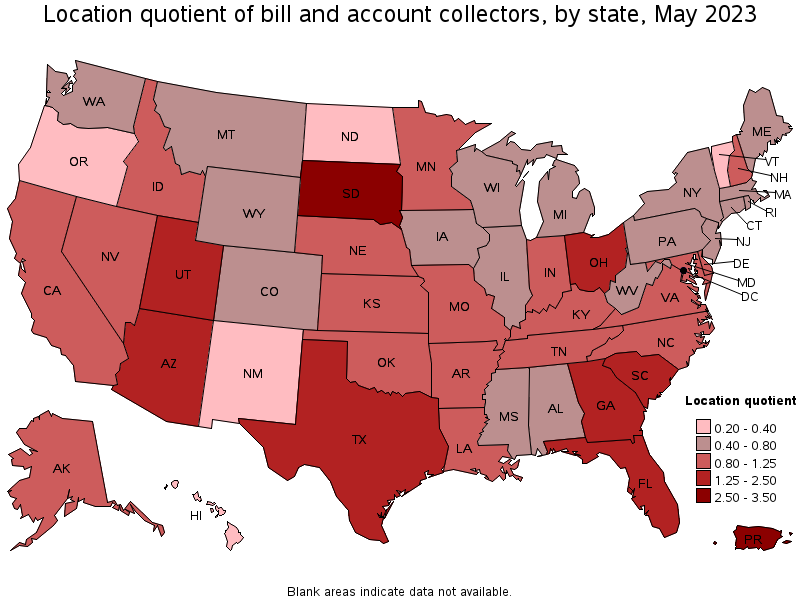
States with the highest concentration of jobs and location quotients in Bill and Account Collectors:
| State | Employment (1) | Employment per thousand jobs | Location quotient (9) | Hourly mean wage | Annual mean wage (2) |
|---|---|---|---|---|---|
| South Dakota | 1,790 | 4.04 | 3.21 | $ 19.63 | $ 40,830 |
| Arizona | 7,350 | 2.35 | 1.87 | $ 21.64 | $ 45,020 |
| South Carolina | 5,160 | 2.32 | 1.85 | $ 18.94 | $ 39,400 |
| Utah | 3,180 | 1.90 | 1.51 | $ 22.09 | $ 45,940 |
| Georgia | 8,740 | 1.84 | 1.46 | $ 20.88 | $ 43,430 |
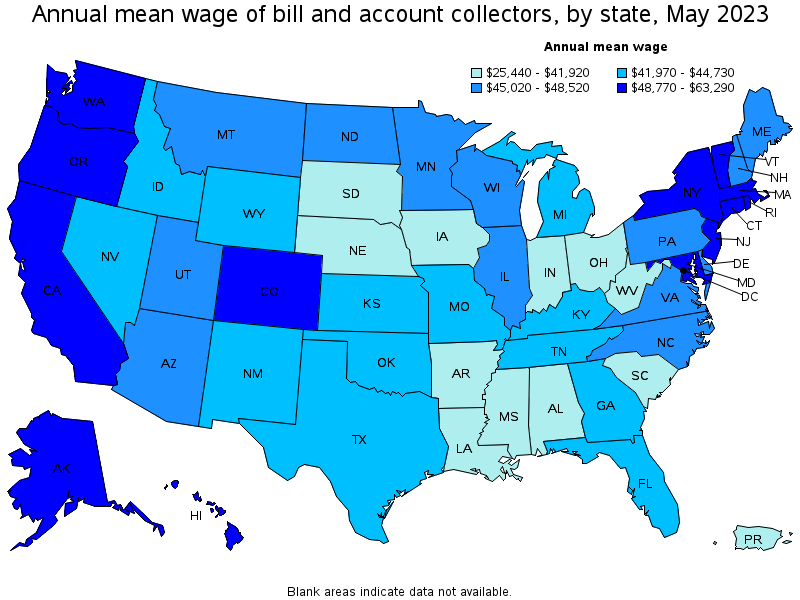
Top paying states for Bill and Account Collectors:
| State | Employment (1) | Employment per thousand jobs | Location quotient (9) | Hourly mean wage | Annual mean wage (2) |
|---|---|---|---|---|---|
| District of Columbia | 300 | 0.42 | 0.34 | $ 30.43 | $ 63,290 |
| Alaska | 310 | 1.01 | 0.80 | $ 27.73 | $ 57,670 |
| Rhode Island | 370 | 0.77 | 0.61 | $ 26.91 | $ 55,960 |
| Massachusetts | 2,690 | 0.74 | 0.59 | $ 26.53 | $ 55,180 |
| California | 23,220 | 1.29 | 1.03 | $ 25.85 | $ 53,770 |
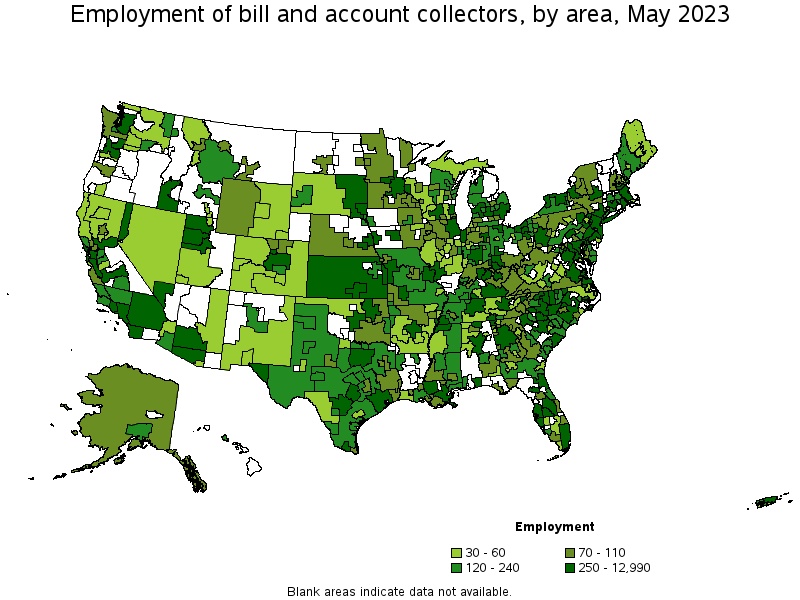
Metropolitan areas with the highest employment level in Bill and Account Collectors:
| Metropolitan area | Employment (1) | Employment per thousand jobs | Location quotient (9) | Hourly mean wage | Annual mean wage (2) |
|---|---|---|---|---|---|
| Los Angeles-Long Beach-Anaheim, CA | 12,990 | 2.10 | 1.67 | $ 24.52 | $ 51,000 |
| Dallas-Fort Worth-Arlington, TX | 8,760 | 2.21 | 1.76 | $ 21.80 | $ 45,350 |
| New York-Newark-Jersey City, NY-NJ-PA | 7,530 | 0.79 | 0.63 | $ 26.64 | $ 55,410 |
| Atlanta-Sandy Springs-Roswell, GA | 6,520 | 2.32 | 1.84 | $ 21.58 | $ 44,880 |
| Phoenix-Mesa-Scottsdale, AZ | 6,160 | 2.69 | 2.14 | $ 21.93 | $ 45,610 |
| Houston-The Woodlands-Sugar Land, TX | 5,180 | 1.63 | 1.29 | $ 20.78 | $ 43,220 |
| Miami-Fort Lauderdale-West Palm Beach, FL | 4,190 | 1.54 | 1.22 | $ 22.21 | $ 46,200 |
| Chicago-Naperville-Elgin, IL-IN-WI | 4,110 | 0.91 | 0.73 | $ 22.91 | $ 47,650 |
| Tampa-St. Petersburg-Clearwater, FL | 3,430 | 2.43 | 1.93 | $ 21.79 | $ 45,320 |
| Philadelphia-Camden-Wilmington, PA-NJ-DE-MD | 3,300 | 1.17 | 0.93 | $ 23.45 | $ 48,780 |
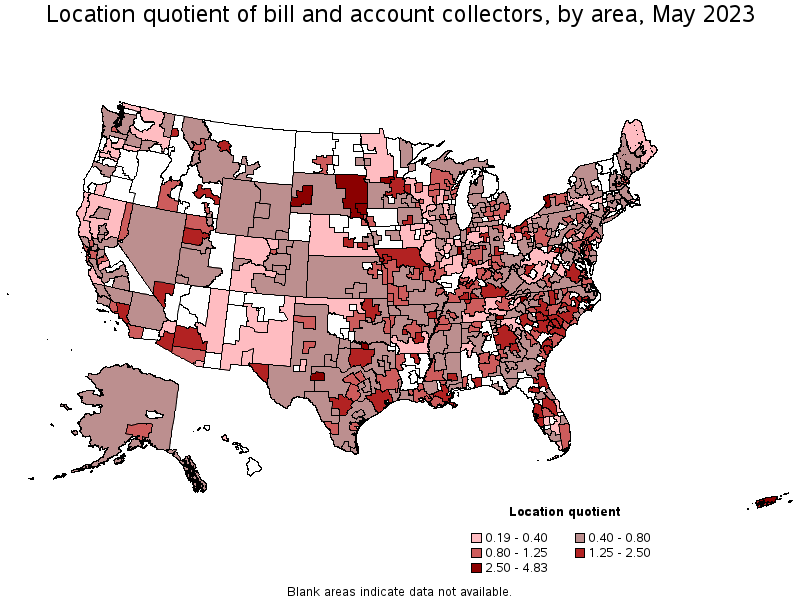
Metropolitan areas with the highest concentration of jobs and location quotients in Bill and Account Collectors:
| Metropolitan area | Employment (1) | Employment per thousand jobs | Location quotient (9) | Hourly mean wage | Annual mean wage (2) |
|---|---|---|---|---|---|
| Johnson City, TN | 500 | 6.07 | 4.83 | $ 16.63 | $ 34,590 |
| Sioux Falls, SD | 960 | 5.80 | 4.61 | $ 20.91 | $ 43,480 |
| Danville, IL | 120 | 4.54 | 3.61 | $ 15.29 | $ 31,800 |
| San Angelo, TX | 210 | 4.20 | 3.34 | $ 16.39 | $ 34,080 |
| Buffalo-Cheektowaga-Niagara Falls, NY | 2,050 | 3.89 | 3.10 | $ 20.47 | $ 42,590 |
| Sherman-Denison, TX | 190 | 3.74 | 2.97 | $ 15.98 | $ 33,240 |
| St. Cloud, MN | 350 | 3.49 | 2.77 | $ 20.52 | $ 42,680 |
| Rapid City, SD | 240 | 3.40 | 2.70 | $ 16.37 | $ 34,040 |
| Cleveland, TN | 150 | 3.27 | 2.60 | $ 16.16 | $ 33,610 |
| Greenville-Anderson-Mauldin, SC | 1,290 | 3.06 | 2.44 | $ 19.67 | $ 40,900 |
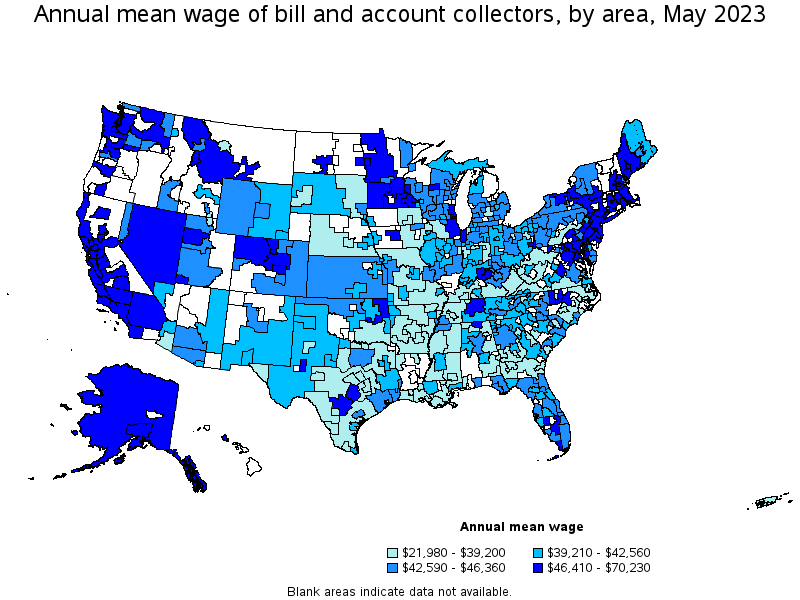
Top paying metropolitan areas for Bill and Account Collectors:
| Metropolitan area | Employment (1) | Employment per thousand jobs | Location quotient (9) | Hourly mean wage | Annual mean wage (2) |
|---|---|---|---|---|---|
| San Jose-Sunnyvale-Santa Clara, CA | 640 | 0.56 | 0.44 | $ 33.76 | $ 70,230 |
| Napa, CA | 100 | 1.23 | 0.98 | $ 32.61 | $ 67,820 |
| San Francisco-Oakland-Hayward, CA | 2,480 | 1.02 | 0.81 | $ 31.80 | $ 66,140 |
| Atlantic City-Hammonton, NJ | 50 | 0.39 | 0.31 | $ 27.88 | $ 57,990 |
| Santa Cruz-Watsonville, CA | 60 | 0.57 | 0.45 | $ 27.64 | $ 57,500 |
| Santa Maria-Santa Barbara, CA | 120 | 0.61 | 0.49 | $ 27.29 | $ 56,770 |
| New Haven, CT | 130 | 0.46 | 0.37 | $ 27.07 | $ 56,300 |
| Santa Rosa, CA | 170 | 0.83 | 0.66 | $ 27.05 | $ 56,260 |
| Sacramento--Roseville--Arden-Arcade, CA | 760 | 0.73 | 0.58 | $ 26.98 | $ 56,120 |
| Anchorage, AK | 210 | 1.26 | 1.01 | $ 26.97 | $ 56,110 |
Nonmetropolitan areas with the highest employment in Bill and Account Collectors:
| Nonmetropolitan area | Employment (1) | Employment per thousand jobs | Location quotient (9) | Hourly mean wage | Annual mean wage (2) |
|---|---|---|---|---|---|
| East South Dakota nonmetropolitan area | 460 | 3.52 | 2.80 | $ 18.85 | $ 39,200 |
| South Central Kentucky nonmetropolitan area | 430 | 2.54 | 2.02 | $ 17.90 | $ 37,220 |
| Southeast Coastal North Carolina nonmetropolitan area | 410 | 1.67 | 1.33 | $ 17.76 | $ 36,940 |
| Piedmont North Carolina nonmetropolitan area | 380 | 1.48 | 1.18 | (8) | (8) |
| Kansas nonmetropolitan area | 320 | 0.83 | 0.66 | $ 20.97 | $ 43,630 |
Nonmetropolitan areas with the highest concentration of jobs and location quotients in Bill and Account Collectors:
| Nonmetropolitan area | Employment (1) | Employment per thousand jobs | Location quotient (9) | Hourly mean wage | Annual mean wage (2) |
|---|---|---|---|---|---|
| East South Dakota nonmetropolitan area | 460 | 3.52 | 2.80 | $ 18.85 | $ 39,200 |
| South Central Kentucky nonmetropolitan area | 430 | 2.54 | 2.02 | $ 17.90 | $ 37,220 |
| North Missouri nonmetropolitan area | 210 | 1.96 | 1.56 | $ 18.83 | $ 39,160 |
| Northeast South Carolina nonmetropolitan area | 180 | 1.94 | 1.55 | $ 20.67 | $ 42,980 |
| Southeast Coastal North Carolina nonmetropolitan area | 410 | 1.67 | 1.33 | $ 17.76 | $ 36,940 |
Top paying nonmetropolitan areas for Bill and Account Collectors:
| Nonmetropolitan area | Employment (1) | Employment per thousand jobs | Location quotient (9) | Hourly mean wage | Annual mean wage (2) |
|---|---|---|---|---|---|
| Alaska nonmetropolitan area | 80 | 0.82 | 0.65 | $ 28.74 | $ 59,790 |
| Northwest Minnesota nonmetropolitan area | 80 | 0.41 | 0.33 | $ 28.07 | $ 58,380 |
| North Coast Region of California nonmetropolitan area | 30 | 0.30 | 0.24 | $ 25.01 | $ 52,020 |
| Southeast Minnesota nonmetropolitan area | 100 | 0.69 | 0.55 | $ 24.94 | $ 51,870 |
| Eastern Washington nonmetropolitan area | 30 | 0.32 | 0.26 | $ 24.20 | $ 50,330 |
These estimates are calculated with data collected from employers in all industry sectors, all metropolitan and nonmetropolitan areas, and all states and the District of Columbia. The top employment and wage figures are provided above. The complete list is available in the downloadable XLS files.
The percentile wage estimate is the value of a wage below which a certain percent of workers fall. The median wage is the 50th percentile wage estimate—50 percent of workers earn less than the median and 50 percent of workers earn more than the median. More about percentile wages.
(1) Estimates for detailed occupations do not sum to the totals because the totals include occupations not shown separately. Estimates do not include self-employed workers.
(2) Annual wages have been calculated by multiplying the hourly mean wage by a "year-round, full-time" hours figure of 2,080 hours; for those occupations where there is not an hourly wage published, the annual wage has been directly calculated from the reported survey data.
(3) The relative standard error (RSE) is a measure of the reliability of a survey statistic. The smaller the relative standard error, the more precise the estimate.
(8) Estimate not released.
(9) The location quotient is the ratio of the area concentration of occupational employment to the national average concentration. A location quotient greater than one indicates the occupation has a higher share of employment than average, and a location quotient less than one indicates the occupation is less prevalent in the area than average.
Other OEWS estimates and related information:
May 2023 National Occupational Employment and Wage Estimates
May 2023 State Occupational Employment and Wage Estimates
May 2023 Metropolitan and Nonmetropolitan Area Occupational Employment and Wage Estimates
May 2023 National Industry-Specific Occupational Employment and Wage Estimates
Last Modified Date: April 3, 2024